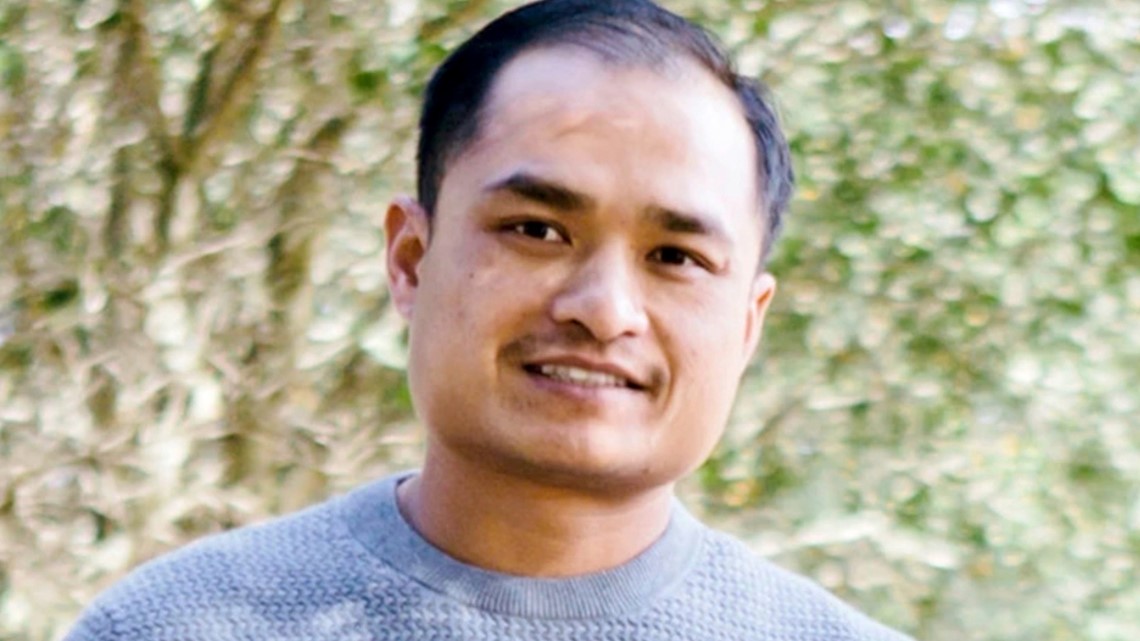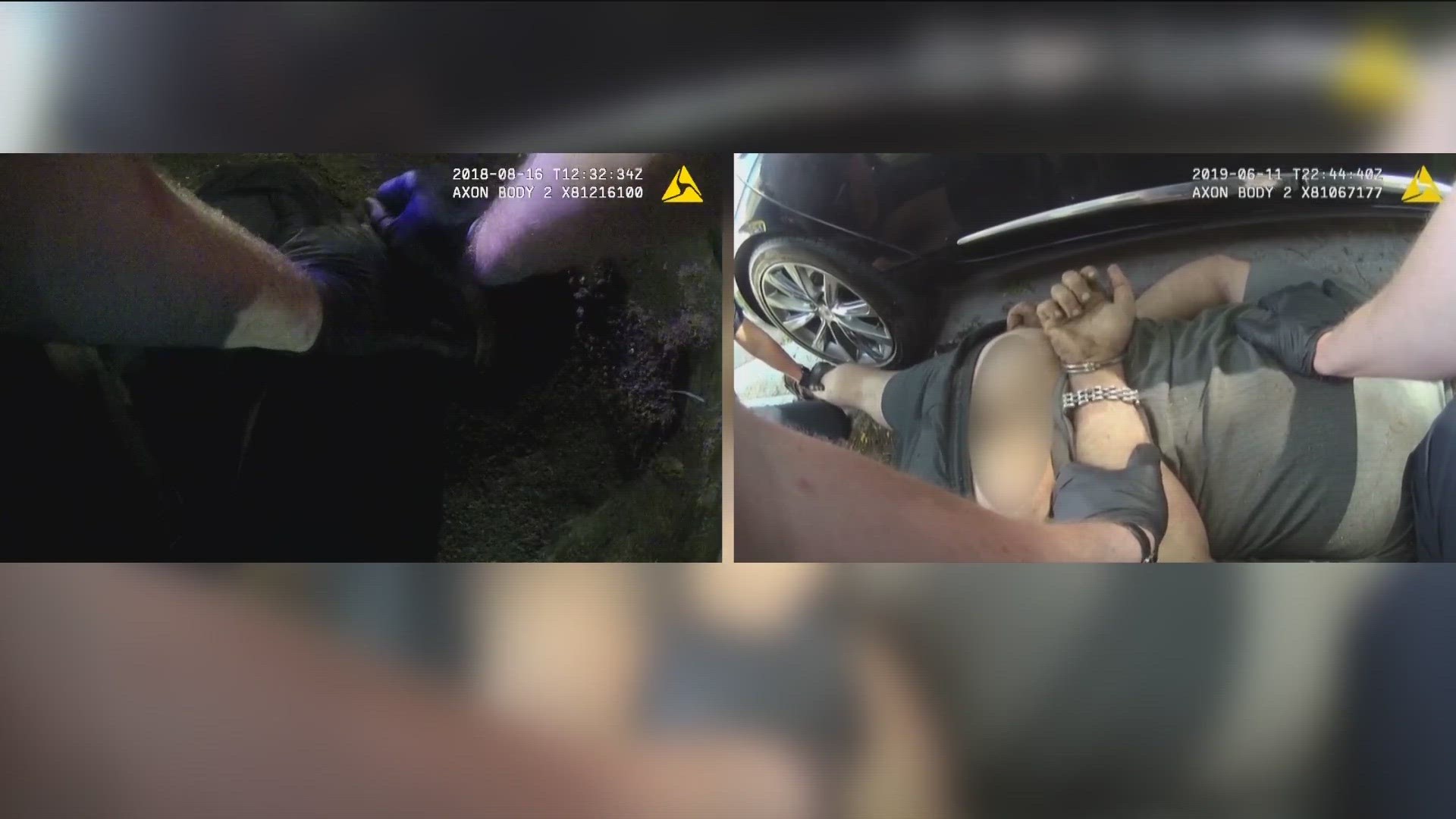SAN DIEGO — "'C'mon, man...dude, it's not like that, man...No, you can't do that...help...help"
Seconds later, 45-year-old Buddy Nichols was dead.
A San Diego police officer who had pushed Nichols head into the grass as he and other officers struggled to handcuff Nichols called dispatch to send an ambulance.
"Can you get medics for us, we are going to have to go 'excited delirium' with soft restraints and a gurney," the officer said to dispatch.
WARNING: THE CONTENT IN THIS VIDEO IS GRAPHIC.
What Is "Excited Delirium"
Excited Delirium, is a condition where people show sudden signs of aggressive and oftentimes bizarre behavior. Symptoms, according to a 2011 report published in the Western Journal of Emergency Medicine, include "shouting, paranoia, panic, violence toward others, unexpected physical strength, and hyperthermia."
The theory has long been used by law enforcement agencies, coroners, and district attorneys to describe the actions seen by some during police encounters. If allowed to intensify, the delirium can put so much strain on the heart that those suffering from it could die.
It states that when people with a history of drug abuse and mental health conditions are placed in high-intensity situations, for example, maximum police restraints, they can grow severely agitated and display feats of superhuman strength prior to their heart giving out and dying.
In recent years, Excited Delirium has been the main legal defense in high-profile excessive force trials throughout the country including George Floyd, Elijah McClain, Daniel Pride, as well as dozens of others.
WATCH: A comprehensive look at excited delirium - KUSA 9 News in Denver
San Diego County's Use of Excited Delirium
According to public records obtained by CBS 8, since 2014, San Diego County District Attorney's Office has mentioned excited delirium as a factor in at least 15 in-custody deaths in San Diego County, according to public documents obtained by CBS 8.
In addition, public records show that the San Diego County Medical Examiner listed the syndrome as a contributing factor in at least two deaths.
Buddy Nichols, the aforementioned man who died during an arrest by San Diego Police Officers, was one of them.
However, the term may soon be tossed aside if a state bill co-authored by San Diego State Assemblymember Dr. Akilah Weber is signed into law.
The Push to Ban Excited Delirium
As drafted, Assembly Bill 360 will prohibit coroners or medical examiners from listing “excited delirium" as the cause of death. If passed it would also ban police officers from using the term in an incident report, however, they could use it as a description of the person's behavior. Lastly, if signed into law, the bill will outlaw the use of excited delirium as evidence in a civil case.
Dr. Weber tells CBS 8 that she had never heard or seen the condition in medical books or papers and says it is not fair to the families of people who die in custody.
"This is what we're telling people that their loved ones died from," says Weber. "If you had someone die from a heart attack, you probably know about it, but if you didn't, you can go and read about it. If you tell someone that their loved one died from excited delirium, and they try and learn more about it, they're going to be even more confused because it's not a true medical definition."
In addition to lacking a true medical definition, Dr. Weber says excited delirium has a history of racist connotations, from its use to justify the death of George Floyd to others.
"It has been disproportionately used on people of color, and particularly, with men. That turns it away from having any medical basis and towards that of a social construct. It made me wonder why I never heard about this during my residency, my med school fellowship, or since I've been in practice."
Lucky Phounsy and Excited Delirium
"There's no amount of money that can bring Lucky back. But it was really important to me, to our family, that the truth comes out," says Loan Nguyen.


Nguyen sat down with CBS 8, months after the County of San Diego agreed to pay her and her two children $12 million to settle a wrongful death lawsuit she filed over the death of her husband, Lucky Phounsy.
Nguyen tells CBS 8 that getting her husband's story out in order to enact change is far more important than any amount of money.
Nguyen says she is still haunted by the day, April 20, 2015, when she and her family agreed to end medical care for her husband.
"I still remember thinking if I was giving up on him. Did I give up on the father of my kids? You know, because I know he wouldn't give up on me."
Six days prior to that fateful decision, while celebrating their son's second birthday at Phounsy's parents home in Santee, Phounsy's mental condition deteriorated rapidly.
His paranoia intensified. He hadn't slept in days. He feared strangers outside of his mother and stepfather's home were trying to hurt his family. He was afraid. He did the first thing that came to his mind; call 911.
It was the last phone call that he would ever make.
"I just heard him on the phone saying that there were people outside," says Nguyen. "I remember his stepdad took the phone and explained to the operator what was going on. When they arrived, his stepfather told them what was going on, that he needed help, that he had no weapons, and that he needed to get to the hospital. They came in and everything just escalated. Quick."
In his parents' hallway, as his young wife was breastfeeding their daughter in the next room, hoping to calm her, deputies stormed inside.
Phounsy, distraught, believing people were out to get him, fought.
Deputies deployed tasers. They managed to get Phounsy to the ground. Nguyen's attorneys say approximately seven deputies used their weight to try and gain control. After an estimated 10 minutes, deputies managed to place Phounsy in a "hogtie," his hands chained to his feet behind his back. He remained in the prone position for what doctors later testified to be 30 minutes before deputies carried him outside and into an ambulance.
Inside the ambulance, former deputy Richard Fischer continued to use force on Phounsy. Fischer testified to using nearly all of his strength, nine on a scale of 10, to push Phounsy's head and torso down. Fischer then applied a "spit sock" on Phounsy's head.
Within minutes, Phounsy's heart stopped.
Six days later, Nguyen and her family chose to remove Phounsy from life support.
Nguyen says shortly after his death, the Sheriff's Department, the District Attorney's Office, and the Medical Examiner formed a narrative on how to describe her husband's death.
"When I first read the medical report the thing that stood out to me was the mention of 'superhuman strength'. And I was like, is this a medical report? How can somebody say that he has superhuman strength? I didn't understand that. And, you know, they said drugs contributed to it," said Nguyen.
Nguyen says her lawsuit helped to tell the real story of her husband's death.
And when a jury awarded her and her children $85 million last year from the county, it only confirmed the story she fought so hard to tell.
Nguyen says the fact that a judge later ruled that amount to be excessive, leading to the $12 million settlement, the largest in-custody death payout in county history, doesn't change the outcome.
"You know, we could have kept our mouths shut. We could have settled with them a long time ago. But it wasn't about that. It was about the truth and it was about accountability. Having them be held accountable for what they did to Lucky. If we can be a voice to make any change, that's what I'm going to continue to do in Lucky's honor."
Nguyen's fight as well as the fight of hundreds of families across the country appear to be having some impact.
Denouncing Excited Delirium
In recent years, many medical organizations have criticized the use of excited delirium. In July 2021, the American Medical Association "denounced" its use as a medical condition.
More recently, other groups have followed suit including, the National Association of Medical Examiners, which announced on March 23 that excited delirium should no longer be listed as a cause of death in autopsies and death investigations.
In its statement, the Association of Medical Examiners says that instead of using 'excited delirium,' the underlying cause contributing to severe agitation and combativeness, whether "natural or unnatural" is listed as the underlying cause of death.
If Assemblymember Akilah Weber's bill passes, then it may be banned for good in California.
Brody McBride represented Loan Nguyen in the first trial against the county.
McBride has since researched excited delirium and questions why the condition is only seen or reported for those who die in police custody or while incarcerated.
"Excited delirium is pseudoscience, plain and simple," says McBride, who specializes in civil rights lawsuits. "I don't think it's actually a legitimate medical condition. In fact, it's really not recognized at all beyond a small group of emergency medicine doctors. But, you know, the symptoms of excited delirium, essentially overlap with the symptoms of somebody experiencing psychosis from mental health issues or acute drug intoxication."
McBride finds it odd that the condition typically is associated with in-custody deaths.
Added McBride, "You don't ever hear of somebody in the throes of excited delirium, making it to the hospital and being treated and saved. This is only something that comes up after somebody dies in police custody after being aggressively restrained, full stop."
Attorneys Mark Fleming and Tim Scott represented Nguyen in her second trial as well in reaching the $12 million settlement.
Fleming and Scott say excited delirium is the go-to defense for public agencies here and elsewhere when trying to defend and excuse in-custody deaths.
"It's absolutely frustrating. It's maddening," says Fleming. "Public agencies continue to promote and continue to rely upon junk science, like excited delirium to justify the true causes of people's in custody deaths. In reality, it is the manner in which they're restrained or excessive force on the part of the officers. There's a certain amount of sadness to it. It's just such an obvious fix to, for example, not binding people's hands and feet behind their backs in a way that clearly restricts breathing. It's an unnecessary, completely unnecessary use of force."
Proponents of Excited Delirium and Ties to San Diego
Dr. Gary Vilke is a UC San Diego professor and Doctor of Emergency Medicine. Vilke specializes in excited delirium. Over the past decade, he has trained police departments including San Diego Police Department and the Sheriff's Department on excited delirium. Dr. Vilke has written papers on the condition and has testified in hundreds on behalf of officers and municipalities who are sued by family members of those who have died in police custody, family members such as Loan Nguyen, Lucky Phounsy's widow.
During the first trial in the Lucky Phounsy case, Dr. Vilke testified that Phounsy's death was not caused by the prone position that he was placed in or the weight of the seven officers on him inside the hallway. Instead, testified Dr. Vilke, Phounsy died from MDMA, also known as Ecstasy, that he took during a trip to Coachella three days prior to the altercation with Sheriff's Deputies. This, despite the fact that toxicology reports taken 65 hours after his hospitalization also showed a trace amount of the drug in his system.
Vilke also said that Phounsy being placed on his stomach, his hands and feet positioned at his waist with the weight of numerous officers did not present any medical warning signs.
Vilke said that because Phounsy was still breathing after deputies carried him out of the house means that nothing in the hallway mattered in regards to Phounsy's ability to breathe.
CBS 8 reached out to Dr. Vilke for comment on his work and on the new legislation from Dr. Akilah Weber and colleagues.
Dr. Vilke said that he was not "familiar with the proposed legislation."
As for the effort to reject the excited delirium condition, Dr. Vilke stated, "Yes – groups are denouncing the term of excited delirium. My involvement in this population of acute patients has always been regarding the assessment and treatment of these highly agitated and delirious individuals who, because of their underlying hyperactive physiology and often concomitant drug intoxication, are at increased first for going into sudden cardiac arrest and dying."
Dr. Vilke said that the name the condition assumes is not the important part. "What people want to call or 'diagnose' these patients with is truly arbitrary. These aggressive and often violent patients are still out in the communities and will continue needing EMS care and emergency department treatments. The [Emergency College of Emergency Physicians] has put out a publication using the term, 'Hyperactive delirium with severe agitation.' Again, the name is not as important as long as the law enforcement and EMS communities recognize the clinical presentation of these patients and continue to facilitate care to optimize clinical outcomes."
Meanwhile, family members such as Nguyen reject any notion that her husband was aggressive or violent or that he has some type of delirium, a delirium that she had not seen in the 16 years of knowing him.
"The hardest thing throughout this whole process is having to raise my kids without their father. That's been everything that we had talked about and dreamed about. All the false narratives around his death. It's hard having to speak to someone about why my husband is no longer here."



